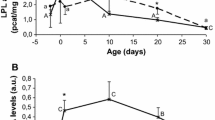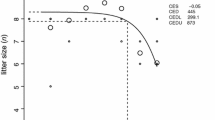Abstract
Our previous work has shown that n-3 fatty acids exert a protective effect against phenytoin-induced cleft palate when phenytoin was administered midgestation [gestational days (GD) 12 and 13] to CD-1 mice. The effects of dietary n-3 fatty acids on phenytoin teratogenicity were investigated at an earlier gestational period (GD 9) to examine whether n-3 fatty acids could exert protective action against other teratogenic effects of phenytoin apart from cleft palate. The effect of phenytoin exposure on maternal hepatic polyunsaturated fatty acid composition was also studied since Δ6 desaturase activity has been shown to be modified by pharmacological action. Female CD-1 mice were fed a standard laboratory diet (SLD), safflower oil (SAFF) or a cod liver/linseed oil (CLO/LO)-based diet for three weeks prior to impregnation and throughout pregnancy. Pregnant mice were administered a single i.p. dose of phenytoin on GD 9, and teratological assessments were performed on GD 19. Tissues were harvested on GD 10 for maternal hepatic phospholipid fatty acid analysis from another group of phenytoin-treated mice. The CLO/LO and the SLD mice, as compared to the SAFF-fed antimals, showed a reduction in total malformations and fetal growth retardation due to phenytoin. Open eye defect was the only anomaly induced by phenytoin in the CLO/LO fetuses while phenytoin produced a variety of malformations in the SAFF fetuses such as tail defects, cleft palate, open eye and absence or blockage of the ureter. Dietary n-6/n-3 fatty acid ratios were reflected in maternal hepatic phospholipids; however, phenytoin exposure appeared to inhibit the conversion of 18∶2n-6 to 20∶4n-6 in the SAFF dams only. These results indicate that the overall protective effects of dietary n-3 fatty acids on phenytoin embryo-toxicity are observed at an early gestational period.
Similar content being viewed by others
Abbreviations
- ANOVA:
-
analysis of variance
- BHT:
-
butylated hydroxytoluene
- CLO/LO:
-
cod liver oil/linseed oil
- FAME:
-
fatty acid methyl esters
- FHS:
-
Fetal Hydantoin Syndrome
- GD:
-
gestational day
- PGF2α :
-
prostaglandin F2α
- PGS:
-
prostaglandin H synthase
- PUFA:
-
polyunsaturated fatty acids
- SAFF:
-
safflower oil
- SLD:
-
standard laboratory diet
- TBA:
-
thiobarbituric acid
- TBARS:
-
thiobarbituric acid reactive substances
References
Hanson, J.W. (1976)Teratology, 13, 185–188.
Kelly, T.E. (1984)Am. J. Med. Genet. 49, 445–450.
Strickler, S.M., Miller, M.A., Andermann, E., Dansky, L.V., Seni, M., and Spielberg, S.P. (1985)Lancet 2, 746–749.
Harbison, R.D., and Becker, B.A. (1970)J. Pharmacol. Exp. Ther. 22, 283–288.
Lum, J.T., and Wells, P.G. (1986)Teratology 33, 53–72.
Elshove, J. (1969)Lancet, 2, 1074.
Eluma, F.O., Sucheston, M.E., Hayes, T.G., and Paulson, R.B. (1984)J. Craniofac. Genet. Dev. Biol. 4, 191–210.
Hansen, D.K., and Hodes, M.E. (1983)Teratology 28, 175–179.
Finnell, R.H. (1981)Science 211, 483–484.
Hansen, D.K. (1991)Proc. Soc. Exp. Biol. Med. 197, 361–368.
Kubow, S., and Wells, P.G. (1989)Mol. Pharm. 35, 504–511.
Kubow, S. (1992)Lipids 27, 721–728.
Mitchell, M.O. Brennecke, S.P., Saeed, S.A., and Strickland, D.M. (1985) inBiological Protection with Prostaglandins (Cohen, M.M. ed.) Vol. 1, pp. 27–44, CRC Press, Boca Raton.
Wells, P.G., Zubovits, J.T., Wong, S.T., Molinari, L.M., and Ali, S. (1989)Toxicol. Appl. Pharm. 97, 192–202.
Roberts, L.G., Laborde, J.B., and Slikker, Jr., W. (1991)Teratology 44, 497–505.
Brenner, R.R., and Peluffo, R.O. (1966)J. Biol. Chem. 241, 5213–5219.
ThornPren, M., and Gustafson, A. (1981)Lancet 2, 1190–1193.
Herold, P.M., and Kinsella, J.E. (1986)Am. J. Clin. Nutr. 43, 566–598.
Lands, W.E.M., and Byrnes, M.J. (1981)Prog. Lipid Res. 20, 287–290.
Nassar, B.A., Das, U.N., Huang, Y-S., Ells, G., and Horrobin, D.F. (1992)Proc. Soc. Exp. Biol. Med. 199, 365–368.
American Institute of Nutrition (1977)J. Nutr. 107, 1340–1348.
Fergusson, M.A., and Koski, K.G. (1990)J. Nutr. 120, 1312–1319.
Swanson, J.E., and Kinsella, J.E. (1986)J. Nutr. 116, 514–523.
Meydani, S.N., Shapiro, A.C., Meydani, M., Macauley, J.B. (1987)Lipids 22, 345–350.
Dahle, I.K., Hill, E.G., and Holman, R.T. (1962)Arch. Biochem. Biophys. 98, 253–261.
Folch, J., Lees, M., and Sloane-Stanley, G.H. (1957)J. Biol. Chem. 227, 497–509.
Kinsella, J.E. (1991) inNutritional and Toxicological Consequences of Food Processing, (Friedman, M., ed.) pp. 255–268, Plenum Press, New York.
Rowland, J.R., Binkerd, P.E., and Hendrickx, A.G. (1990)Reprod. Toxicol. 4, 191–202.
Juaneda, P., and Rocquelin, G. (1985)Lipids 20, 40–41.
Chapman, J.R., and Roberts, D.W. (1984)Teratology 30, 107–117.
Harbison, R.D., and Becker, B.A. (1969)Teratology 2, 305–312.
Harris, M.J., Juriloff, D.M., and Biddle, F.G. (1984)Teratology 29, 287–295.
Harris, M.J., and Juriloff, D.M. (1986)J. Embryol. Exp. Morph. 91, 1–18.
Maconnachie, E. (1979)J. Embryol. Exp. Morph. 49, 259–276.
Burch, R.M., Luini, A., and Axelrod, J. (1986)Proc. Natl. Acad. Sci. USA 83, 7201–7205.
Cunnane, S.C., Kent, E.T., McAdoo, K.R., Caldwell, D., Lin, A.N., and Carter, D.M. (1987)J. Invest. Dermatol. 89, 395–399.
Author information
Authors and Affiliations
About this article
Cite this article
High, K.A., Kubow, S. n-3 fatty acids inhibit defects and fatty acid changes caused by phenytoin in early gestation in mice. Lipids 29, 771–778 (1994). https://doi.org/10.1007/BF02536699
Received:
Revised:
Accepted:
Issue Date:
DOI: https://doi.org/10.1007/BF02536699




